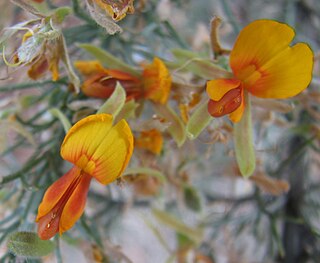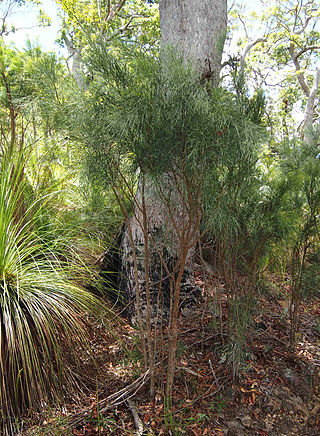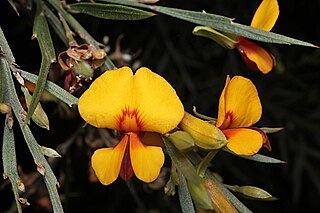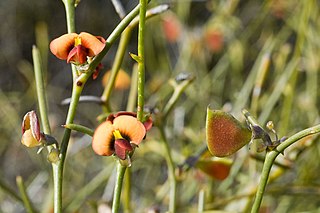
Jacksonia furcellata, commonly known as grey stinkwood, is a species of flowering plant in the family Fabaceae and is endemic to the south-west of Western Australia. It is a prostrate to low-lying, or weeping erect shrub with greyish-green branches, sharply-pointed side branches, its leaves reduced to scales leaves, yellowish-orange flowers, and woody, hairy pods.

Jacksonia sericea, commonly known as waldjumi, is a species of flowering plant in the family Fabaceae and is endemic to the south-west of Western Australia. It is a spreading to prostrate shrub with greyish-green branches, straight, sharply-pointed side branches, leaves reduced to scales, orange flowers with red markings, and woody, densely hairy pods.

Jacksonia sternbergiana, commonly known as stinkwood, is a species of flowering plant in the family Fabaceae and is endemic to the south-west of Western Australia. The Noongar peoples know the plant as kabbur, koorpa or mondurn. It is an erect or weeping shrub or tree with dull green branches, straight, sharply-pointed side branches, its leaves reduced to scales, yellowish-orange flowers, and woody, hairy pods.

Jacksonia scoparia, commonly known as dogwood or winged broom-pea, is a species of flowering plant in the family Fabaceae and is endemic to Queensland and eastern New South Wales. It is a shrub or small tree with angled or winged branchlets, leaves usually reduced to scales, cream-coloured to orange-yellow flowers and oblong, hairy pods.

Eutaxia parvifolia is a species of flowering plant in the family Fabaceae and is endemic to southwestern Western Australia. It is a shrub with reddish brown stems, elliptic to egg-shaped leaves with the narrower end towards the base, and mostly yellow, red or orange flowers, with yellow red or orange markings.

Hakea recurva, commonly known as jarnockmert, is a flowering shrub or small tree in the family Proteaceae and is endemic to an area in the Mid West, northern Wheatbelt and the Goldfields-Esperance regions of Western Australia. It has creams-white to yellow flowers and thick, prickly, curved leaves.

Jacksonia lehmannii is a is a species of flowering plant in the family Fabaceae and is endemic to the south-west of Western Australia. It is an erect to prostrate or spreading, spindly shrub with greyish-green branches, sharply-pointed side branches, its leaves reduced to scales leaves, yellowish-orange flowers with orange-red markings, and woody, hairy pods.

Jacksonia horrida is a species of flowering plant in the family Fabaceae and is endemic to the south-west of Western Australia. It is an erect or spreading to prostrate, bushy shrub with greyish-green branches ending in short, flattened, sharply-pointed side branches, the leaves reduced to scales and the flowers scattered and yellow-orange with red markings.

Jacksonia anthoclada is a species of flowering plant in the family Fabaceae and is endemic to the south-west of Western Australia. It is an erect, single-stemmed shrub with hairy, elliptic to egg-shaped phylloclades with sharply-pointed edges, yellow-orange flowers with red markings, and hairy, woody pods.

Daviesia major is a species of flowering plant in the family Fabaceae and is endemic to the south-west of Western Australia. It is an erect, many-stemmed shrub with scattered, erect, sharply-pointed, cylindrical phyllodes and orange and red flowers.
Daviesia podophylla, commonly known as buggery bush, is a species of flowering plant in the family Fabaceae and is endemic to the south-west of Western Australia. It is an openly-branched, glabrous, glaucous shrub with many often sharply-pointed branchlets, triangular phyllodes with a sharp point on the end, and orange-yellow, dark red and black flowers.

Daviesia quadrilatera, commonly known as buggery bush, is a species of flowering plant in the family Fabaceae and is endemic to the south-west of Western Australia. It is a robust, erect, glabrous shrub with angular branchlets, vertically flattened, sharply-pointed quadrilateral or triangular phyllodes with a sharp point on the end, and yellow to orange and red flowers.

Daviesia retrorsa is a species of flowering plant in the family Fabaceae and is endemic to the south of Western Australia. It is a dense, tangled shrub with glabrous branchlets and leaves, scattered, needle-like, sharply pointed phyllodes turned backwards, and orange-yellow and red flowers.

Daviesia tortuosa is a species of flowering plant in the family Fabaceae and is endemic to the south-west of Western Australia. It is a spreading, glabrous shrub with tangled, zigzagging branchlets, sharply-pointed, narrowly elliptic phyllodes, and yellow flowers with faint orange markings.

Jacksonia acicularis is a species of flowering plant in the family Fabaceae and is endemic to the west of Western Australia. It is an erect, spindly shrub with very sharply-pointed short side branches, leaves reduced to scales, orange flowers with red markings, and densely hairy pods.

Jacksonia aculeata is a species of flowering plant in the family Fabaceae and is endemic to the northern Australia. It is a spreading shrub with sharply-pointed, hairy, short side branches, leaves reduced to scales, lemon-yellow flowers, and woody, hairy pods.

Jacksonia alata is a species of flowering plant in the family Fabaceae and is endemic to the south-west of Western Australia. It is a tufted, semi-prostrate to erect shrub with flattened branches, sharply-pointed side branches or phylloclades, leaves reduced to narrowly lance-shaped scales, yellow-orange flowers with a red "eye", and woody, densely hairy pods.

Jacksonia angulata is a species of flowering plant in the family Fabaceae and is endemic to the south-west of Western Australia. It is a tufted, spreading to prostrate shrub often with zig-zagged branches, sharply-pointed side branches or phylloclades, leaves reduced to broadly egg-shaped scales, yellow-orange to orange flowers with a red "eye", and woody, densely hairy pods.

Jacksonia arenicola is a species of flowering plant in the family Fabaceae and is endemic to the south-west of Western Australia. It is an erect, broom-like shrub with densely hairy, sharply-pointed phylloclades, yellow-orange flowers with red markings, and woody pods that are hairy at first, later glabrous.

Jacksonia argentea is a species of flowering plant in the family Fabaceae and is endemic to the far north of Western Australia. It is an erect, silver-grey shrub with flattened, narrowly lance-shaped to narrowly elliptical cladodes or phylloclades, bright yellow flowers, and woody hairy pods.


















